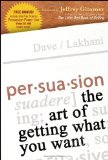Featured
Posted by Ian Brodie on December 7th, 2008.
Ian Brodie on December 7th, 2008.

 Making the Number is a new book focused on Sales Benchmarking by Greg Alexander, Aaron Bartels and Mike Drapeau. The book sets out a clear methodology for benchmarking sales activities and performance and shows readers what to measure, how to measure it, and how to use this information to improve sales performance.
Making the Number is a new book focused on Sales Benchmarking by Greg Alexander, Aaron Bartels and Mike Drapeau. The book sets out a clear methodology for benchmarking sales activities and performance and shows readers what to measure, how to measure it, and how to use this information to improve sales performance.
There's a lot to like about the book – but also a number of points I'd disagree with.
Let's take the positives first:
A Book Whose Time Has Come
In many ways, this is a book that's long overdue. As the authors point out – almost every function of business is measured and benchmarked in some way – yet there is a reluctance in many organisations to use the same rigour in measuring sales. Sales is often regarded as more art than science. Yet is there any reason why sales should be less measurable and less “benchmarkable” than, say, R&D or HR?
Sure, there are a wide variety of factors which influence any sale – many of them difficult if not impossible to measure directly. And often there are many random and uncontrollable factors which affect outcomes. But there are equally as many imponderable factors in other business functions too. As long as measures are used intelligently – something we'll come back to later – then they can help improve business performance enormously.
A Clear Methodology
The authors set out a very clear methodology for sales benchmarking – right from initiating the project, to defining and collecting data, to analysing the data, making improvements and working to sustain those improvements. They cover both activity level and strategic level metrics, and include much information on how to overcome the obstacles to implementing sales benchmarking.
Details and Depth
There are many useful examples and case studies in the book – and many lists of typical metrics which can be used to benchmark sales performance. There are also details for the mathematically challenged on how to calculate standard deviations and percentiles. I also appreciated the detailed notes on each chapter with references and links for follow-up research.
Intelligent Use of Metrics through Hypothesis Testing
For me, the best chapter in the book is on “Focused Action”. In particular, the use of a hypothesis testing approach to intelligently use sales metrics to understand the true issues and take appropriate action. The hypothesis testing approach described takes understanding from the level of “bronze customer deal size is 32% below peers” to the reasons why. Perhaps the issue is lack of value being delivered, or perhaps it is not being communicated well enough to customers. The hypothesis testing approach identifies what the underlying issue is (and hence what the right corrective action to take is) in a data driven manner.
Concerns with the Book
Overall, I found the book very worthwhile – and would recommend it to all sales leaders looking to improve the performance of their function in a rigorous manner.
However, I do have a number of concerns which potential readers should bear in mind:
Selling What You've Already Bought
A minor concern – but a particular bugbear of mine – is that so many books nowadays seem to spend a large portion of their early pages “selling themselves”. In this case, there are 40 or so pages justifying why sales benchmarking is so important. To be frank, if I've just bought a book on sales benchmarking I don't need convincing why it's important. Fine, include arguments like this later on in the book as examples of what to say to convince others. But you don't need to sell the concept to me – I wouldn't have bought the book if I needed convincing.
Types of Sales Activities Covered
Most of the examples in the book are geared around a transactional model of sales activity – essentially a “call based” model. The basic underlying equation used is
revenue = activities x conversion x transaction x talent x time
The logic is that by carrying out more activities, converting more of those activities into sales, getting a higher value from each sale, having more sales resources, or more available time for selling – then revenue will go up.
This model is valid for some industries – for example the primary care salesforces of pharmaceutical companies mainly work in this way. Selling is done in short sales calls (“details”) where products are discussed with the physicians. These activities are clearly measurable – and that's exactly what the pharma companies do. In other cases, sales may be driven by running public workshops, or RFP responses – distinct, measurable activities.
But other sales activities aren't so measurable. When sales professionals go networking, or keep in touch with existing or prospective clients – can we really just measure the number of these activities? Or in reality, aren't sales primarily driven by the quality of these activities – not the quantity?
For me, where sales are driven primarily by relationships – as the majority of sales in my sector of professional services are – they become very difficult to quantify. Not necessarily impossible – but difficult, and benchmarking these qualitative factors is something the book steers clear of.
Comparability
Another area of concern I have is with the comparability of activities for benchmarking. The approach used in the book (and by Sales Benchmarking Index – the company the authors founded) is to group the salesforce to be benchmarked by size, industry, sales model (solution providers, missionaries, etc.), channel type and geography.
This is much better than taking a simplistic “one size fits all” approach – but is it really valid to compare metrics from firms even within the same categories?
For example, within the pharmaceutical industry again, the activities of salesforces selling to general practitioners versus hospital specialists are very different. In one model, sales are driven by short, standardised calls of a few minutes long. In the other, meetings are long, complex technical briefings and interactions. Metrics like the number of calls and the length of calls from these different models can't be validly compared. Even within the same model of selling to general practitioners – the activities when selling “new to the market products” are very different from selling mature products. Even when selling “new to the market” products, the activities can be very different for selling new products with similar properties and methods of action to existing products vs selling a completely new product which requires significant education of the medical community.
Even within the same company, selling exactly the same products and services, different salespeople can be highly successful using radically different methods. In his excellent book Creating Rainmakers, Ford Harding reports from his extensive studies of highly successful sellers of professional services that Rainmakers share very few common characteristics. They all had a “system” for generating sales – but the system varied significantly based on the skills, experience and preferences of the individual. Some rainmakers maintain extensive networks, others are experts at making cold calls, others nurture a small number of very close client relationships. All are successful – but simple measurements and comparisons of call rates, meetings attended, presentations made etc. cannot give guidance as to what the right levels of these activities are. Some salespeople will make very few calls – others will make many. Which approach is right? It's very much dependent on the individual – not on a universal measure of “best practice”.
What to do with the Numbers
Even if you do have exactly comparable situations – how do we turn the benchmarks into action? The main example from the book highlights some of the difficulties here.
In the example, benchmarking reveals that although Acme Corporation has a higher average deal size than its peers for its large (Platinum & Gold) customers; its average deal size for small (Bronze) customers is well below that of its peers. The book then goes on to analyse why that might be the case, and to propose actions to address the situation to get the Bronze customer deal size up to par.
But is this really the right way to proceed? An alternative interpretation of the data is that Acme is really suited to working with larger clients. Perhaps its salesforce understand big company culture and decision-making well. Perhaps its products are particularly suited to big companies. So perhaps a better strategy than trying to get the average deal size up for small customers is to abandon those small customers and focus sales efforts on the larger customers it's already doing well with. It could well be that by playing to its strengths, Acme can become far more successful than simply trying to emulate its peers across the board.
And this highlights one of the main dangers of benchmarking. Instead of encouraging companies to think strategically and to focus on areas where they have unique capabilities, it encourages “me too”-ism. The basic path of benchmarking is to identify areas where your firm is “weak” and to attempt to pull those up to peer group level. But the risk with this is that you risk diluting and weakening the very reasons why you are strong in other areas. Companies – like people – have unique bundles of interrelated strengths and weaknesses. Often, trying to “fix” the weaknesses can damage the very things that give the company its strengths.
Of course, there's nothing in benchmarking generally or this book in particular that forces you to take this “fix the weak areas” approach rather than thinking more strategically about maximising strengths. But it's no surprise that that's the approach given in the books main example – and that's the approach almost always adopted when benchmarking. It seems to make sense – yet it can actually be quite dangerous.
Summary
Now please, don't take the above to mean I don't think this isn't an excellent book – it is. And it's really the only good book on sales benchmarking available.
But to all of you keen to embark on sales benchmarking – while lauding your enthusiasm – I must remind you to avoid the pitfalls I've mentioned:
- Make sure that you have good measures for your most important sales areas – don't just focus on the easily measured ones
- Make sure you have a valid comparison group to benchmark against
- Make sure you apply the results intelligently – don't just unthinkingly focus on improving the worst areas. Think first about whether you need to do those areas at all – or whether you're better off focusing and improving what's already good than on trying to fix something you're just not good at.
Ian
 Business Networking is a vital sales tool for professionals and salespeople alike – yet it's one that many people struggle with.
Business Networking is a vital sales tool for professionals and salespeople alike – yet it's one that many people struggle with. Painful Truth #1 – Your Customers are Busy
Painful Truth #1 – Your Customers are Busy

 But if what you are proposing to do falls under the remit of the potential client or other person with influence over the buying decision then you had better be careful. It could well be that a belief you are challenging is their belief that they need to be seen as not having any weaknesses in their capabilities. In other words, if they need you to help them, doesn't that make them a bad manager? Shouldn't they be able to do this stuff themselves? Very often potential clients are seriously concerned about whether hiring you may make them look weak in the eyes of their managers, staff and peers. What you are selling challenges their belief that they need to be “on top” of all the activities in their remit.
But if what you are proposing to do falls under the remit of the potential client or other person with influence over the buying decision then you had better be careful. It could well be that a belief you are challenging is their belief that they need to be seen as not having any weaknesses in their capabilities. In other words, if they need you to help them, doesn't that make them a bad manager? Shouldn't they be able to do this stuff themselves? Very often potential clients are seriously concerned about whether hiring you may make them look weak in the eyes of their managers, staff and peers. What you are selling challenges their belief that they need to be “on top” of all the activities in their remit. If you're anything like me, you're constantly juggling priorities and deadlines and struggling to keep on top of a ton of key activities.
If you're anything like me, you're constantly juggling priorities and deadlines and struggling to keep on top of a ton of key activities. How do you turn an initial contact with a prospect into a fully-fledged business relationship? It's the essence of sales – but it's an area where many people really struggle.
How do you turn an initial contact with a prospect into a fully-fledged business relationship? It's the essence of sales – but it's an area where many people really struggle. I've been “tagged” by Ford Harding to take part in an interesting concept: a “blog meme” – a series of posts by different bloggers on the same topic.
I've been “tagged” by Ford Harding to take part in an interesting concept: a “blog meme” – a series of posts by different bloggers on the same topic. Ok, so perhaps not the person you'd most expect to be dishing out vital sales tips – but as it turns out, this year's Spongebob Annual (UK edition) has avery useful piece in it.
Ok, so perhaps not the person you'd most expect to be dishing out vital sales tips – but as it turns out, this year's Spongebob Annual (UK edition) has avery useful piece in it.
